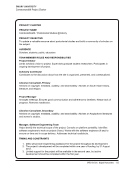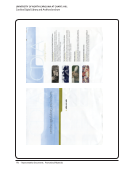SPEC Kit 326: Digital Humanities · 39
Our GIS scanner/large scale printer is available to all users but all other services are restricted to library-sponsored
projects.
Researchers from other institutions working in partnership with a university researcher.
Service infrastructure is currently under development.
Students require faculty sponsor.
These are offered as services we perform, not generally as resources people are able to access directly (not a public
service per se).
Walk in, non-affiliates.
We may make strategic partnerships with people from outside the institution but only where there is also a faculty
member involved.
We would like to develop the resources to be able to offer post-docs.
14. How do they find out the services are available? Check all that apply. N=48
Communications from library subject liaisons 41 85%
Library website 37 77%
Print or electronic publications 24 50%
Events 23 48%
Email 20 42%
Orientations for newcomers 18 38%
Social media, such as Facebook or Twitter 14 29%
Use of your institution’s communications office 10 21%
Other method, please describe 18 38%
At this point, quite informally, through conversation at meetings and Open Access Week events.
CDLA staff participate in campus events, such as those offered by the Institute for the Arts and Humanities.
Coordinator in College of Arts and Sciences.
Faculty using our collections ask for the help of curators in developing projects. Or faculty may approach library
administrators asking for help in formulating grant proposals which have library components.
Library communications office.
Participation in campus steering group for digital research in humanities, arts and architecture, social and information
sciences. Ongoing collaborations with other campus units.
Our GIS scanner/large scale printer is available to all users but all other services are restricted to library-sponsored
projects.
Researchers from other institutions working in partnership with a university researcher.
Service infrastructure is currently under development.
Students require faculty sponsor.
These are offered as services we perform, not generally as resources people are able to access directly (not a public
service per se).
Walk in, non-affiliates.
We may make strategic partnerships with people from outside the institution but only where there is also a faculty
member involved.
We would like to develop the resources to be able to offer post-docs.
14. How do they find out the services are available? Check all that apply. N=48
Communications from library subject liaisons 41 85%
Library website 37 77%
Print or electronic publications 24 50%
Events 23 48%
Email 20 42%
Orientations for newcomers 18 38%
Social media, such as Facebook or Twitter 14 29%
Use of your institution’s communications office 10 21%
Other method, please describe 18 38%
At this point, quite informally, through conversation at meetings and Open Access Week events.
CDLA staff participate in campus events, such as those offered by the Institute for the Arts and Humanities.
Coordinator in College of Arts and Sciences.
Faculty using our collections ask for the help of curators in developing projects. Or faculty may approach library
administrators asking for help in formulating grant proposals which have library components.
Library communications office.
Participation in campus steering group for digital research in humanities, arts and architecture, social and information
sciences. Ongoing collaborations with other campus units.
































































































































































































